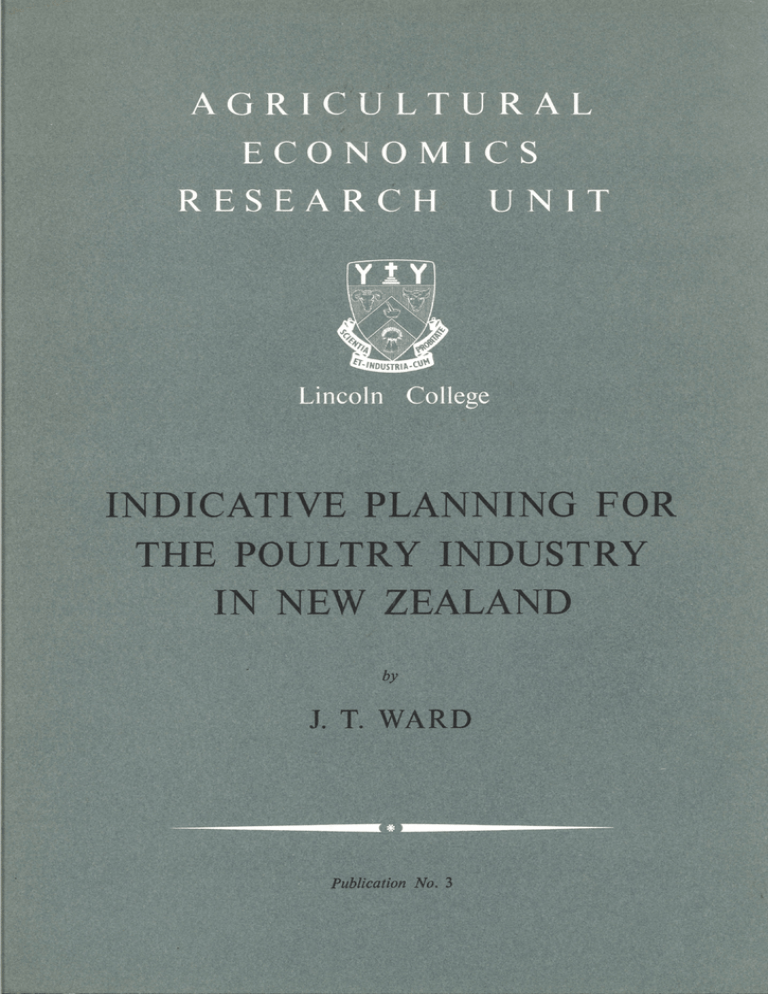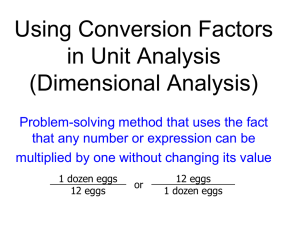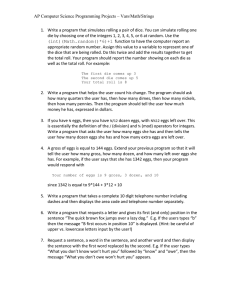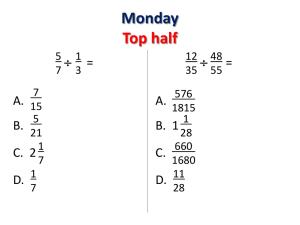Document 13070889
advertisement

INDICNrIVE PLANNING ]?OB. THE POULTRY INDU'STRY
IN NEW ZEALAND
J" T" WiLRD
Senior Lecturer in Agricultural Economics
Lincoln College
(Universi ty of' Canter'bury)
Agricultural Economics Research Unit Publication No o 3
A paper presented to the 11th Poultry Parmers' Ref'resher
Course at Lincoln College:p 12 - 1L~ May 9 1964<>
THE AGRICULTURAL ECONOMICS RESEARCH UNIT
Unit was established in 1962 at Lincoln College with an
anp.ual grant from the Department of Scientific and Industrial
Research. This general grant has been supplemented by grants
from the Wool Research Organisation, the Nuffield Foundation
and the New Zealand Forest Service for specific research projects.
The Unit has on hand a long-term programme of research in
the fields of agricultural marketing and agricultural production,
resource economics, and the relationship between agriculture and
the general economy. The results of these research studies will be
published as Unit reports from time to time as projects are completed. In addition, it is intended to produce other bulletins which
may range from discussion papers outlining proposed studies to
reprints of papers published or delivered elsewhere. All publications will be available to the public on request.
THE
STAFF
Director
Professor B. P. Philpott, M.Com., M.A{Leeds), AR.AN.Z.
Research Officers
R. H. Court, M.A, B.Sc.
A R. Frampton, B.Agr.Sc.
R. J. Townsley, M.Agr.Sc.
Research Assistants
Miss M. J. Matheson, B.Sc.
E. D. Parkes, B.Agr.Sc.
LINCOLN COLLEGE LECTURING STAFF ASSOCIATED WITH
THE UNIT'S RESEARCH PROJECTS:
J. T. Ward, B.Litt.{Oxon.), B.Sc.(Econ.), Ph.D.{Lond.)
Senior Lecturer in Agricultural Economics
J. D. Stewart, M.A, Ph.D.{Reading)
Senior Lecturer in Farm Management
PREFACE
From time to time the Agricultural Economics
Research Unit proposes to
~ublish
discussion papers
which, as their title suggests, aim at stimulating
interest and discussion on specific topics in
agricultural economicse
This~
the first of these discussion papers, was
given as an address to the Lincoln College Poultry
Farmers 1 Refresher CourseQ
In the paper Dr" Ward presents some tentative
projections for the poultry industry for 1973, and
indicates what economic research is required to improve
this
t~pe
of forecasting which is essential to
planning the orderly development of the industry
Lincoln College
28 May, 1964
B., P .. Philpott
0
INDICATIVE
P~TING
FOR THE POULTRY INDUSTRY
IN :NEW ZEAlAND
Introduction
Until a couple of years ago teconomic planning'
Was barely discussed in this country, although it
has been adopted with striking success in Japan and
several European countries
a Conservative government
including Britain under
c
Recently however the
idea has caugpt on here and has been given impetus
and status by its use in the Agricultural Development
Conference 0
The concept of planning has changed in
Western countries during the past decade;
the old
idea of detailed planning, involving physical controls
(import licences, building licences and the like) has
been replaced by a much broader and more flexible
concept;
'Indicative PlanningfG
The central planning
ag~ncy
postulates a deSirable
rate of economic growth (a percentage rise in the
standard of living) and then analyses the implications
of this rate for the various sectors of the economy.
State organisations and private firms within these
sectors then design their own investment and production
2
plans to take account of the overall design.
Successful planning on these lines requires new
economic techniques - sector accounting, process
analysis, linear programming - Which are being
developed rapidly overseas aided materially by the
electronic computer.
This type of planning still
leaves freedom for enterprise but ensures that
enterprise is carried out within broad guiding lines.
Coupled with sympathetic fiscal and monetary polieies
it has been an important factor in the striking
growth rates of the Japanese and French economies
over recent years.
There are now indications that,
at least within certain areas, there is a growing
interest in indicative planning in New Zealand, and
as we have seen it is the basis of the Agricultural
Development Conference.
Expansion Targets
First let us consider the expansion targets
Which have been av.nounced by the AgrieuJ.turaJ.
Development Oonference.
i)
Wha. t is -their basis?
The Treasury has taken the Government Statistician's
projection of population (assuming an immigration rate
of 10,000 annualJ.y) over the next ten years.
This
gives a projected population of just over 3 miJ.J.ion
in 1973.
3
2)
4
It has assu,1ned a compoTI..."J.d grc:;wth of' G"N .. P .. of'
per cent per annum over 'the decade",
Assuming no
deterioration in ourtex'ms o:f trade and allowing for
popula tion growth w this mean,s a l"jGe in real income
per head or standard of' liv:l.ng of' 2% per annum ..
This
is not startling in the l.ight; of' the achievements of'
some other countr:tesbu,t it is better than we have
managed over the las t. decade <'>
3)
On t;he basis of '"'Ghese projections the Treasury
has calculated that by '1972/73 m:rr x'equirements for'
visible imports would. reach £569 m" compared with
£254 mo f'or 1962/63" valued. at
is a rise of' £'115 mo or
4.)
Our deficdt on
W
45;1~
c~onstant
prices",
This
over the deeadeo
invisi'bles g :in the balance of'
payments is a1.so likely to rise rapidly over the
decade$' re~lchi:ng £138 mo by 1972/73G
5)
To meet these requirements :for visi'ble and
invisible imports the value of' exports will need to
rise frOID £300 ID" in 1962/63 to £467
compound rise of'
4t
In", by
1972/73, a
per cent. pel'" annum o
The next stage in the plan is to est.imate the
level of' produetion that will be necessary to meet this
export target and. to analyse ways and means of' achieving
this level of' prod,uctio:n.o
4
I 'Ur.1derstand thtit although the Poultry Board
was re:presented on somf3 of' the Conf'erence Oommittees,
no :program.11le has been draw:n
u.p :EOI'
the poultry
industry on the ground.s that its production is overwhelmingly f'or the domsstie market and that it is
unlikely to enter oveI'seas markets which are domina ted
by low cost producers in America and Europeo
But
surely t.he fact tha t you d.o not intend to export does
not necessarily mean that this type of planning is not
relevant to your industry,
I
thought therefore that
the best contribution I could make to the Conference
would be to explain what indicat.ive planning is and
then apply it broadly te, the pouJ_try industryo
this is one
man~s
Since
effort over 45 minutes it will not
cover the detail of 11+ committees working over 12
months,.
I hope"
hOli1lever~
at least to stimulate
discussion in the line of' approach"
The Cons}.1IDption
oL~s in_19§~
Calculations are on a per head per year basis
and include eggs consumed in all f'orms..
authori tative
:t~i.gure
No
is available but it is possible
to make a broad estimate f'rom several sources
Q
5
a)
N Z .. Official Year Book for
de
Q
a f'igure of' 25 dozen for 19604
962 (P., 734) gives
The basis of' this
f'igtlre is the number of' eggs hand,led by licensed
distributors to which is added estimates of' production
from other sources based on numbers of' poultry recorded
at the 5 yearly censuses.,
The Year Book suggests
that consumption has been rising at around one dozen
a year (4 per cent) in recent years but it seems that
this trend may have been based on the rise in
commercial productiono
A prlvate communication
f'rom the Government Statistician suggests that the
allowance made f'or
Wbackyard~
production and
9
0ver
the f'ence i sales may have been too high in the light
of' the detailed 1961 Poultry Oensus figures which are
now available ..
b)
A basically similar approach published in the
N.. Zo Poultry World (December
'1963~
p .. 617) gave an
estimated consumption of' 21 dozen ..
c)
An alternative approach in the same publication
used the average consum,ptio:n. :r..>ecorded in a small
scale :food survey to arrive at a figure of' 27 dozen
per head f'or the population as a wholeG
I propose that we strike a broad average of' these
calculations and, allowing f'or some upward trend 1
settle :for an average consumption of' 25 dozen eggs
6
per head in 1963 ..
Total
Consumption~in Ne~l
Zealand
On the basis of a total populat.ion of 2,512,000
in 1963 (N$Z90&Y~Bc 1962~ p947) this would give a
total consumption of 63 million dozen eggs in that year.
,Sources of Eggs
The NoZ$ Poultry Board Report for 1963 records
25.8 million dozen shell eggs handled through licensed
distributors..
It also records a surplus of 5 .. 4
million dozen eggs of which apparently two thirds or
3 .. 6 million dozen were processed for sale in New
Zealand..
This gives a total consumption through
Egg Marketing Authority channels of 29 .. 4 million dozen,
eQuivalent to 47 per cent of the est,imated total
consumption..
In summary, the New Zealander consumes
on average about 25 dozen eggs a year9 of which he
obtains nearly 12 dozen from licensed distributors,
and rather more than 13 dozen from
~sideliners'
or from
the fowl houses or cages in his own or his neighbours'
backgardens ..
According to the 1961 Census there are over
100,000 households keeping less than one dozen fowls
and almost 150 9 000 keeping less than two dozen..
there were only 644,000 households in New Zealand
As
7
in 1961 the total number of householders keeping
poultry amounts to 1 in 4 over the country as a whole.
We are clearly a nation of backyard poultry keepers.
Projections for
197~
Now we turn to projections fOl" 1973 ..
The total demand or consumption for any commodity
is largely determined by rour major factorso
1)
Total population
2)
Income level
3)
Price of the commodity
4)
Taste
Taste is a subjective element which, for some
goods (such as long pointed shoes) maybe
capriciouse
Q1.1i te
For most staple foodstuffs however it
is not subject to marked changes except over long
periods of timec
Each of the other factors is capable
of measurement and we :find that for any demand study
estimates or projections of' total population and of
income and price are vital components of' the analysis.
The concepts of income elasticity of demand and price
elasticity of demand are important tools in the
economist~s
type ..
research kit f'or a demand study of this
8
With population gr:'owing at the present rate
and assuming an immigTation of 10 19 000 a year we shall
just pass the 3 millj.on m<;3.rk in 1973 ..
The Agricultural
Development Conference also assumes that our real
standard of living wi,
rise "by 2% per annum..
Woo t
effect will these ehanges have upon the demand for
eggs?
a)
We must make the analysis in two
steps~
Eo£ulatio~
Assuming no change in the present consumption rate lP
total consumption in 1973mrill be
3.082 million x 25 dozen
b)
= 77
million dozene
.:f£lc9J!!~~
To calculate this correctly we would need to
know the income elasticity of demand :for eggs i..e., the
ra'te at which expenditure on eggs per head increased
for a 1 per cent rise :!.n 1-'ea1 incomeso
Work has been
done on this in the UoKo and U"S .. Ao but we have no
knowledge at all about it in New Zealand..
made in the UoKo
pre~war
of demand of 1 .. 3 (Stone)..
A study
showed an income elasticity
With the big rise in real
income in Britain since then 9 income elasticity of
demand for eggs is likely to have
fallen~
The rapid
rise in consumption recorded in Britain over recent
9
years (4 per cent :per annum) may be largely attributable
to the eff'ects of' price changes and marked changes in
supply and marketing..
If' we assumed an income
elasticity of' demand for eggs in New Zealand of' 0..,5
then a projected rise in real incomes of' 2 per cent
per annnID would result in a rise in egg consumption
This lIvould mean that on
of' 1 per cent per annum"
income grounds alone, f'or every d.ozen eggs consumed
today 1 .. 105 dozen would be C0l1,S:l1.i'11ec.1 in 1973..
Applying
this fac'tor to our previous estimate of' 77 million
dozen we have 77 (1e10S)
~
85 million dozen f'or the
country as a whole;9 or- almost 28 dozen per head ..
A consumption of' 330 eggs is very high by world
standards but still short of' the 30 dozen set by your
I~
egg-a.-day" slogan",
the
UoSoA~
A few years ago consumption in
was above this figJre (around 360) but it
has fallen back to about 310 at the present time ..
Consumption in Canada reached 300 a few years ago but
has fallen slightly since then, while in Australia
the increase in egg consumption is only keeping pace
with the increase in population and is not rising per
head of populationQ
Reasons for this are not known
but $,:,re probably mainly due to ehanges in diets>
especially a move towards a fcontinental breakfast?
instead of an English breakfaste
However, estimates
of total consumption at three possible levels of'
10
consumption per head are given in Table 10
TABLE 1
ESTIMATED CONSUMPrION
(For a population of
1973
3~082,OOO)
Total Consumptin
million
dozen
Consumption
per head
doz/year
77
85
92
Price Elasticity of Demand
So much for the probable effects of population
and income on egg consumption - what now of price?
We do not know the price elasticity of demand for
eggf? in New
Zealand~
to changes in price..
(Senior)
sugg~sts
that is the response of consumption
Recent figures for the U.. K..
a price elasticity of -003 there.,
This means in round figures that a 10% fall in price
would bring about only a
3%
increase in consumption.
It appears that in Britain the quality and presentation
of eggs are more important factors than price in
selling themo
(In paSSing we might note that if demand
relationships in New Zealand are Similar to those
in Britain a
3%
increase in supply above the level
required to :match increases in population and income
levels would depress, egg prices by 10% ..
The fall
11
in egg prices in New Zealand over the last year
certainly indicates that rising production has had
a signif'icant ef'fect upon priceo)
In an interesting paper that Mr" Cowdrey gave
to the Poultry Conference at Massey last year he
discussed various methods of' advertising f'or sales
promotion but he had very little to say about the
eff'ect of priceo
I would like to suggest to you
however that the price elasticity of' demand for
eggs~
through licensed distriQ'9:tors,!!_.i::;; probably Significantly
higher in this country than in the United Kingdom or
the UoS@A@
1)
There are two reasons for this hypothesis:
Elasticity is always greater at higher prices
than at lower pI-ices ~ and the retail price of eggs
in New Zealand is high by world standards especially
at this time of the year ioe" late autumn/earlY wintere
It is conceivable that a greater supply of' eggs at
this time of the year9 though selling at slightly
lower
prices~
could bring in greater receiptsjJ and
possibly greater profits, to the
industry~
It would
undoubtedly be of' major benefit to the consumer&
2)
It seems probable that even if a fall in egg
prices did not encourage New Zealanders to eat many
more eggs it would probably encourage them to buy more
regularly through the sUpermarkets and the grocerso
12
It would surely discourage them f'rom keeping a :few
:fowls at the bottom of' the g3.rden or from buying loose
eggf? :from somebody else who keeps a :few at the bottom
o:f his gardeno
A change in. this direction is clearly
discernible in the marked :fall in small :flocks
recorded in the Poultry Appendix to the 1961 Census
(Table 2)0
This is the :first time such a :fall has
been recordedo
It is significant that it has occurred
over a period when the retai,l price of' eggs has :fallen
in relative termso
The ta'ble shows a large fall in the number of'
backyard :flocks..
It is interesting to note that the
greatest proportionate :fall has been in the number of'
:flocks with between 50 and 200 birds..
Some of' the people
f'ormerly running such :flocks may well have f'ound that
keepinK mOl"e birds than are necessary :for their own
households is not worthwhile at lower. margins, others
will have given up poultry altogether, while a f'ew may
have moved into the ranks o:f larger :flockso
I believe that this trend is likely to be
accen tua ted over the next decade and 'tha t i t will
particularly a:f:fect the urban householder rather than
the rural one who usually has a bit more space, easier
access to cheap grain and less stringent local by=lawso
The large number
or
backyard f'locks in urban areas is
shown in Table 3 extracted :f".rom the 196'1 Census '"
THE DISTRIBUTION OF FOWLS
BY SIZE OF FLOCK
TABLE 2
Number of' Number of' f'locks
f'owls in
f'lock ,__ .1956
1~61
Absolute
change
Percentage
change
~
1 - 12
115783
102224
- 13,559
-
13 - 24
58019
4.5894
- 12$'125
- 21%
25 - 49
10270
7108
3843
;';-99
999
50 - 199
200
=
500
Sources~
31%
3,162
=
2602
"1,241
- 32%
1067
883
184
- 17%
569
623
+
54
521
773
+
252
+ 48%
190072
160'107
- 29,965
- 16%
1000 & over
Total
12%
=
+
9%
Population Censuses (Poultry Appendices)
1956 & 1961 ..
TABLE 3
BACKYARD FLOCKS IN URBAN AREAS 1961
~- of' f'lock
1 - 12'
,%
Rumber of' f'locks
48,537
24
11,044
25 =49
1,028
74
208
75 - 99
82
13
50
100
=
~
=
200
Total
(below 200 birds)
"16g
61,061
The total number of f'locks with less than 200 birds
represents 99@4 per cent of' the total f'locks in
urban areas ..
14
Factors likely to accentuate the trend in the
next decade are ~
1)
A more assured supply of' good quality eggs
available all the year rOl1:nd in the supermarkets and
grocers at reasonable prices",
2)
Better packinlZ and grading of' eggs sold retail
(which your Boa:cd has already encmxf.'aged) <>
3)
Rising living standards
~
with higher incomes
people carrr!ot be bothered to keep :fowls especially
if' it interferes with the weekend at; the bacho
4)
Growing concentrat,ion of' the population in the
large towns with :fewer f'8.oi11 ties :for and g1:'eat;:r
nuisance value o:f poultrYe
The move toward small,er seetions <>
A :fowl house
at the bottom of a 40 perch section is one thing - a
fowl house together 'with a elothes drier, a double
garage (and a boat port) on 24 perches is anothero
6)
Te levisi.ono
The spread o:f television and the
expansion 01' programmes is likely to affect the small
part time poultry keeper, as it has af:fected the
home gardener :l,n other c01.lntries.,
(O:f course thel"e will always -be some people who keep
chooks for interestWs sake or as pets for the childrenQ
I am one myself'
<0
Af'ter a
q~y
discussing economics
with students I f'ind it very relaxing to help my small
boys f'eed a pen of' Black Australorpso
But if' I could
get good Quality, decent E;i;ized eggs at 3/6 - 4/- per
dozen all the year round Ifd keep budgerigars or
tropical fish insteado)
The decline in the number of' 'backyard' and
smaller
~sideline~
f'locks will be ref'lected in an
increase in the proportion of eggs sold through the
egg floors ..
It is not
pos~ible
to predict the
magni tude of' this change without some Quantitative
of the price elasticity of' demand and of'
knowledg~
the elasticity of supply of these small producers.
I propose therefore to set up a number of possible
fproportionate sales 9 and show the levels of throughput that would resulto
4
THROUGHPUT OF EGG FLOORS IN 1 973
UNDER VARYING ASSUMPTIONS
% of total
consumpt61%
47%
75%
Esti~ated
'on
consumntion
Million.. -. Million Million
Million
dozen
dozen
dozen
dozen
TABLE
~
77
36
47
58
85
40
52
64
92
43
56
69
II
These figures should be compar.t:!d with a throughput of'
31 million dozen in 1963 ..
Estimated
cons~"91l112~tJ.on
oL£.gg:s
B;llli".:t,~lPO~ughput
of' egg floors
The range of' values i'o:r' estimated consumption and
for floor sales as a proportion. of total consumption
are purely assumptions taken to illustrate the 'model' ..
A ori tical part of this
'\~,)rpe
of' forward planning is
in determining what are the most realistic assumptions ..
In order to do this satisfactorily it is essential to
make Cluantitative studies of the income elasticity of
demand and the price elasticity of demand f'or eggs in
New Zealand ..
The priee elasticity of' demand for eggs
through lj.censed di,Strlbutorf3 will in turn be strongly
influenced by the elasticity of' supply of small
producers ..
I would like to s'nggest that determining
the values of these elastj"ci ti.ea ywuld be a vital
piece of' research for the industry.,
In general terms
proba:ble that there
S!
wj~ll
however'j it appears highly
'be a continued rise in total
egg consumption and that an j.nc:;?easing proportion of
the supply will be sold. through licensed distributors"
On the production side we shall pro'bably witness a
further decline in the nuY£ibeI' of'
small
?
~backyarders ~
and
sideliners wand an inc:ceas6 in the number of
modern, highly efficient.!' large scale producers"
Inclicative planning would go on from a calculation
of' egg consumption and sources of supply to calculate
num-bers of' birds in the national flockw their
17
distribution by size of
req~irements
f'lo(~k:p
breed.ing flocks JI
:for :feed, capital and labour, transport,
egKf'loors capacity, retail outlets and so on . .
Tab Ie ch:i;.cken
A second aspect o:f the poultry industry which
I have not discussed at all is the production of'
table chicken ..
By this I mean
~b:C'oilers
9
although I
kno'w the t.rade dislikes the word" and not culled hens1>
Wi th annual consumption o:f poul.try in New Zealand. at
only
4 Ibs per head there is surely an enormous potential
f'or expansion in this class of' white meat..
I should
not be so :foolhardy as to suggest we could look f'orward
to an export trade in thi.s product against the
commercial giants of Ameriea and Britain.,
B11t if' we
could induce people within New Zealand to eat more
poultry we should not only enrich our national diet
(and :find more :favour wi.th the tourists) but we Should
also indirectly make available supplies of' red meat
Which we £ould..l?ell overseas$
This section of' the
industry has only just started in New Zealand but it is
already progressing more rapidly than was anticipated.
One
larg~
distributor 9 who only began to handle this
class o:f poultry in 19579 is processing a quarter of' a
million birds this year..
The expansion of' this section
of' the industry could clearly far outweigh the expansion
of' egg:production during the next decade ..





